Cooperation between Two Micro-Grids Considering Power Exchange: An Optimal Sizing Approach Based on Collaborative Operation
Abstract
1. Introduction
1.1. Literature Review
1.2. Contributions and Organization
- (1)
- An optimal sizing model of photovoltaic, wind turbine, battery and tie line for two micro-grids based on collaborative operation was established, and the cost comparison for sizing of each micro-grid under independent mode and interconnected mode was analyzed.
- (2)
- The power exchange between two micro-grids under interconnection is analyzed.
- (3)
- A sensitivity analysis is made for the price of power transaction between interconnected micro-grids to find the optimal price which makes the stake-holders prefer to be interconnected.
2. Configuration of the Two Micro-Grids System
3. Input Data
4. Problem Formulation
4.1. Objective Function
4.2. Economic System Modeling
4.2.1. The Initial Investment Cost
4.2.2. The Operation and Maintenance Cost
4.2.3. The Replacement Cost
4.3. Physical System Modeling
4.3.1. PV System
4.3.2. Wind Turbine (WT)
4.3.3. Battery Storage
4.4. Collaborative Operation Strategy and Simulation
4.5. Constraints
4.5.1. Component Constraints
4.5.2. Battery Constraints
4.5.3. Loss of Power Supply Probability (LPSP)
4.5.4. The Power Exchange Limitation
5. Case Study
5.1. Parameters
5.2. Results and Discussion
5.2.1. Economic Analysis of the Proposed Model
5.2.2. Power Exchange Analysis
5.2.3. Sensitivity Analysis of Power Transaction Price
6. Conclusions
Author Contributions
Funding
Conflicts of Interest
Abbreviations
| the total annual cost (AC) of the interconnected micro-grids system | price for unit cost of the tie line | ||
| the annual cost of MGA | load demand at time t | ||
| the annual cost of MGA | amount of unbalanced power of interconnected micro-grid at time t | ||
| the annual cost of k | total power generated by WT of k at time t | ||
| capacity for the tie line | total power generated by PV of k at time t | ||
| G | perpendicular radiation at array surface | power shortage at time t | |
| unit initial investment cost for component j of k | power demand at time t | ||
| annual cost of initial investment for component j of k | power exchange at time t | ||
| i | the discount rate | maximum for power exchange | |
| j | photovoltaic panels, wind turbines or battery storage | annual cost of replacement for component j of k | |
| k | MG A or MG B | unit replacement cost for component j of k | |
| maximum for loss of power supply probability | solar insolation in one instant of time t | ||
| installed number for component j of k | power loss rate of tie line | ||
| lifetime for component j of k | aging rate for battery | ||
| upper bound of installation amount for PV | state of charge of battery at time t | ||
| upper bound of installation amount for WT | upper bound for SOC of battery | ||
| upper bound of installation amount for battery | lower bound for SOC of battery | ||
| lifetime for tie line | wind speed at the instant time t | ||
| the cycle for each DOD | cut-in wind speed of WT | ||
| annual cost of operation and maintenance for component j of k | cut-out wind speed of WT | ||
| annual cost of operation and maintenance for component j of k | rated wind speed of WT | ||
| power supplied by each PV at time t | annual growth rate of operation and maintenance cost for component j of k | ||
| rated power of PV panel | photovoltaic module efficiency | ||
| power supplied by each WT at time t | inverter efficiency | ||
| rated power of WT | battery efficiency | ||
| power generated by renewable energy |
References
- Adefarati, T.; Bansal, R.C. Reliability and economic assessment of a microgrid power system with the integration of renewable energy resources. Appl. Energy 2017, 206, 911–933. [Google Scholar] [CrossRef]
- Ahadi, A.; Kang, S.K.; Lee, J.H. A novel approach for optimal combinations of wind, PV, and energy storage system in diesel-free isolated communities. Appl. Energy 2016, 170, 101–115. [Google Scholar] [CrossRef]
- Xu, Z.; Yang, P.; Zheng, C.; Zhang, Y.; Peng, J.; Zeng, Z. Analysis on the organization and Development of multi-microgrids. Renew. Sustain. Energy Rev. 2017, 81. [Google Scholar] [CrossRef]
- Ismail, M.S.; Moghavvemi, M.; Mahlia, T.M.I.; Muttaqi, K.M.; Moghavvemi, S. Effective utilization of excess energy in standalone hybrid renewable energy systems for improving comfort ability and reducing cost of energy: A review and analysis. Renew. Sustain. Energy Rev. 2015, 42, 726–734. [Google Scholar] [CrossRef]
- Markvart, T. Sizing of hybrid photovoltaic-wind energy systems. Sol. Energy 1996, 57, 277–281. [Google Scholar] [CrossRef]
- Celik, A.N. Optimisation and techno-economic analysis of autonomous photovoltaic-wind hybrid energy systems in comparison to single photovoltaic and wind systems. Energy Convers. Manag. 2002, 43, 2453–2468. [Google Scholar] [CrossRef]
- Koutroulis, E.; Kolokotsa, D.; Potirakis, A.; Kalaitzakis, K. Methodology for optimal sizing of stand-alone photovoltaic/wind-generator systems using genetic algorithms. Sol. Energy 2006, 80, 1072–1088. [Google Scholar] [CrossRef]
- Chedid, R.; Rahman, S. Unit sizing and control of hybrid wind-solar power systems. IEEE Trans. Energy Convers. 1997, 12, 79–85. [Google Scholar] [CrossRef]
- Katti, P.K.; Khedkar, M.K. Alternative energy facilities based on site matching and generation unit sizing for remote area power supply. Renew. Energy 2007, 32, 1346–1362. [Google Scholar] [CrossRef]
- Ferrer-Martí, L.; Domenech, B.; García-Villoria, A.; Pastor, R. A MILP model to design hybrid wind-photovoltaic isolated rural electrification projects in developing countries. Eur. J. Oper. Res. 2013, 226, 293–300. [Google Scholar] [CrossRef]
- Zhao, B.; Zhang, X.; Li, P.; Wang, K.; Xue, M.; Wang, C. Optimal sizing, operating strategy and operational experience of a stand-alone microgrid on Dongfushan Island. Appl. Energy 2014, 113, 1656–1666. [Google Scholar] [CrossRef]
- Ma, T.; Yang, H.; Lin, L. A feasibility study of a stand-alone hybrid solar–wind–battery system for a remote island. Appl. Energy 2014, 121, 149–158. [Google Scholar] [CrossRef]
- Silvente, J.; Kopanos, G.M.; Pistikopoulos, E.N.; Espuña, A. A rolling horizon optimization framework for the simultaneous energy supply and demand planning in microgrids. Appl. Energy 2015, 155, 485–501. [Google Scholar] [CrossRef]
- Bekele, G.; Tadesse, G. Feasibility study of small Hydro/PV/Wind hybrid system for off-grid rural electrification in Ethiopia. Appl. Energy 2012, 97, 5–15. [Google Scholar] [CrossRef]
- Bekele, G.; Palm, B. Feasibility study for a standalone solar-wind-based hybrid energy system for application in Ethiopia. Appl. Energy 2010, 87, 487–495. [Google Scholar] [CrossRef]
- Montuori, L.; Alcázar-Ortega, M.; Álvarez Bel, C.; Domijan, A. Integration of renewable energy in microgrids coordinated with demand response resources: Economic evaluation of a biomass gasification plant by Homer Simulator. Appl. Energy 2014, 132, 15–22. [Google Scholar] [CrossRef]
- Hurtado, E.; Peñalvo-López, E.; Ángel, P.-N.; Vargas, C.; Alfonso, D. Optimization of a hybrid renewable system for high feasibility application in non-connected zones. Appl. Energy 2015, 155, 308–314. [Google Scholar] [CrossRef]
- Aagreh, Y.; Al-Ghzawi, A. Feasibility of utilizing renewable energy systems for a small hotel in Ajloun city, Jordan. Appl. Energy 2013, 103, 25–31. [Google Scholar] [CrossRef]
- Luna-Rubio, R.; Trejo-Perea, M.; Vargas-Vázquez, D.; Ríos-Moreno, G.J. Optimal sizing of renewable hybrids energy systems: A review of methodologies. Sol. Energy 2012, 86, 1077–1088. [Google Scholar] [CrossRef]
- Xiao, J.; Bai, L.; Li, F.; Liang, H.; Wang, C. Sizing of Energy Storage and Diesel Generators in an Isolated Microgrid Using Discrete Fourier Transform (DFT). IEEE Trans. Sustain. Energy 2014, 5, 907–916. [Google Scholar] [CrossRef]
- Atia, R.; Yamada, N. Sizing and Analysis of Renewable Energy and Battery Systems in Residential Microgrids. IEEE Trans. Smart Grid 2016, 7, 1204–1213. [Google Scholar] [CrossRef]
- Diaf, S.; Diaf, D.; Belhamel, M.; Haddadi, M.; Louche, A. A methodology for optimal sizing of autonomous hybrid PV/wind system. Energy Policy 2007, 35, 5708–5718. [Google Scholar] [CrossRef]
- Saito, N.; Niimura, T.; Koyanagi, K.; Yokoyama, R. Trade-off analysis of autonomous microgrid sizing with PV, diesel, and battery storage. In Proceedings of the 2009 IEEE Power & Energy Society General Meeting, Calgary, AB, Canada, 26–30 July 2009; pp. 1–6. [Google Scholar]
- Karavas, C.S.; Arvanitis, K.G.; Kyriakarakos, G.; Piromalis, D.D.; Papadakis, G. A novel autonomous PV powered desalination system based on a DC microgrid concept incorporating short-term energy storage. Sol. Energy 2018, 159, 947–961. [Google Scholar] [CrossRef]
- Wang, X.; Wang, C.; Xu, T.; Guo, L.; Li, P.; Yu, L.; Meng, H. Optimal voltage regulation for distribution networks with multi-microgrids. Appl. Energy 2018, 210, 1027–1036. [Google Scholar] [CrossRef]
- Hu, M.; Weir, J.D.; Wua, T. Decentralized operation strategies for an integrated building energy system using a memetic algorithm. Eur. J. Oper. Res. 2012, 217, 185–197. [Google Scholar] [CrossRef]
- Hu, M.; Weir, J.D.; Wu, T. An augmented multi-objective particle swarm optimizer for building cluster operation decisions. Appl. Soft Comput. 2014, 25, 347–359. [Google Scholar] [CrossRef]
- Nikmehr, N.; Najafi-Ravadanegh, S.; Khodaei, A. Probabilistic optimal scheduling of networked microgrids considering time-based demand response programs under uncertainty. Appl. Energy 2017, 198. [Google Scholar] [CrossRef]
- Lv, T.; Qian, A. Interactive energy management of networked microgrids-based active distribution system considering large-scale integration of renewable energy resources. Appl. Energy 2016, 163, 408–422. [Google Scholar] [CrossRef]
- Ouammi, A.; Dagdougui, H.; Dessaint, L.; Sacile, R. Coordinated Model Predictive-Based Power Flows Control in a Cooperative Network of Smart Microgrids. IEEE Trans. Smart Grid 2015, 6, 2233–2244. [Google Scholar] [CrossRef]
- Nikmehr, N.; Ravadanegh, S.N. Optimal Power Dispatch of Multi-Microgrids at Future Smart Distribution Grids. IEEE Trans. Smart Grid 2015, 6, 1648–1657. [Google Scholar] [CrossRef]
- Haddadian, H.; Noroozian, R. Multi-microgrids approach for design and operation of future distribution networks based on novel technical indices. Appl. Energy 2017, 185, 650–663. [Google Scholar] [CrossRef]
- Kou, P.; Liang, D.; Gao, L. Distributed EMPC of multiple microgrids for coordinated stochastic energy management. Appl. Energy 2017, 185, 939–952. [Google Scholar] [CrossRef]
- Karavas, C.S.; Kyriakarakos, G.; Arvanitis, K.G.; Papadakis, G. A multi-agent decentralized energy management system based on distributed intelligence for the design and control of autonomous polygeneration microgrids. Energy Convers. Manag. 2015, 103, 166–179. [Google Scholar] [CrossRef]
- Christos-Spyridon Karavas, K.A.; Papadakis, G. A Game Theory Approach to Multi-Agent Decentralized Energy Management of Autonomous Polygeneration Microgrids. Energies 2017, 11, 1756. [Google Scholar] [CrossRef]
- Zha, J.; Wu, J.; Zhao, D. Changes of probabilities in different wind grades induced by land use and cover change in Eastern China Plain during 1980–2011. Atmos. Sci. Lett. 2016, 17, 264–269. [Google Scholar] [CrossRef]
- Layadi, T.M.; Champenois, G.; Mostefai, M.; Abbes, D. Lifetime estimation tool of lead–acid batteries for hybrid power sources design. Simul. Model. Pract. Theory 2015, 54, 36–48. [Google Scholar] [CrossRef]
- Fathy, A. A reliable methodology based on mine blast optimization algorithm for optimal sizing of hybrid PV-wind-FC system for remote area in Egypt. Renew. Energy 2016, 95, 367–380. [Google Scholar] [CrossRef]
- Borowy, B.S.; Salameh, Z.M. Methodology for optimally sizing the combination of a battery bank and PV array in a Wind/PV hybrid system. IEEE Transa. Energy Convers. 1996, 11, 367–375. [Google Scholar] [CrossRef]
- Nafeh, E.S. Optimal Economical Sizing Of A PV-Wind Hybrid Energy System Using Genetic Algorithm. Int. J. Green Energy 2011, 8, 25–43. [Google Scholar] [CrossRef]
- Ahmadi, S.; Abdi, S. Application of the Hybrid Big Bang–Big Crunch algorithm for optimal sizing of a stand-alone hybrid PV/wind/battery system. Sol. Energy 2016, 134, 366–374. [Google Scholar] [CrossRef]
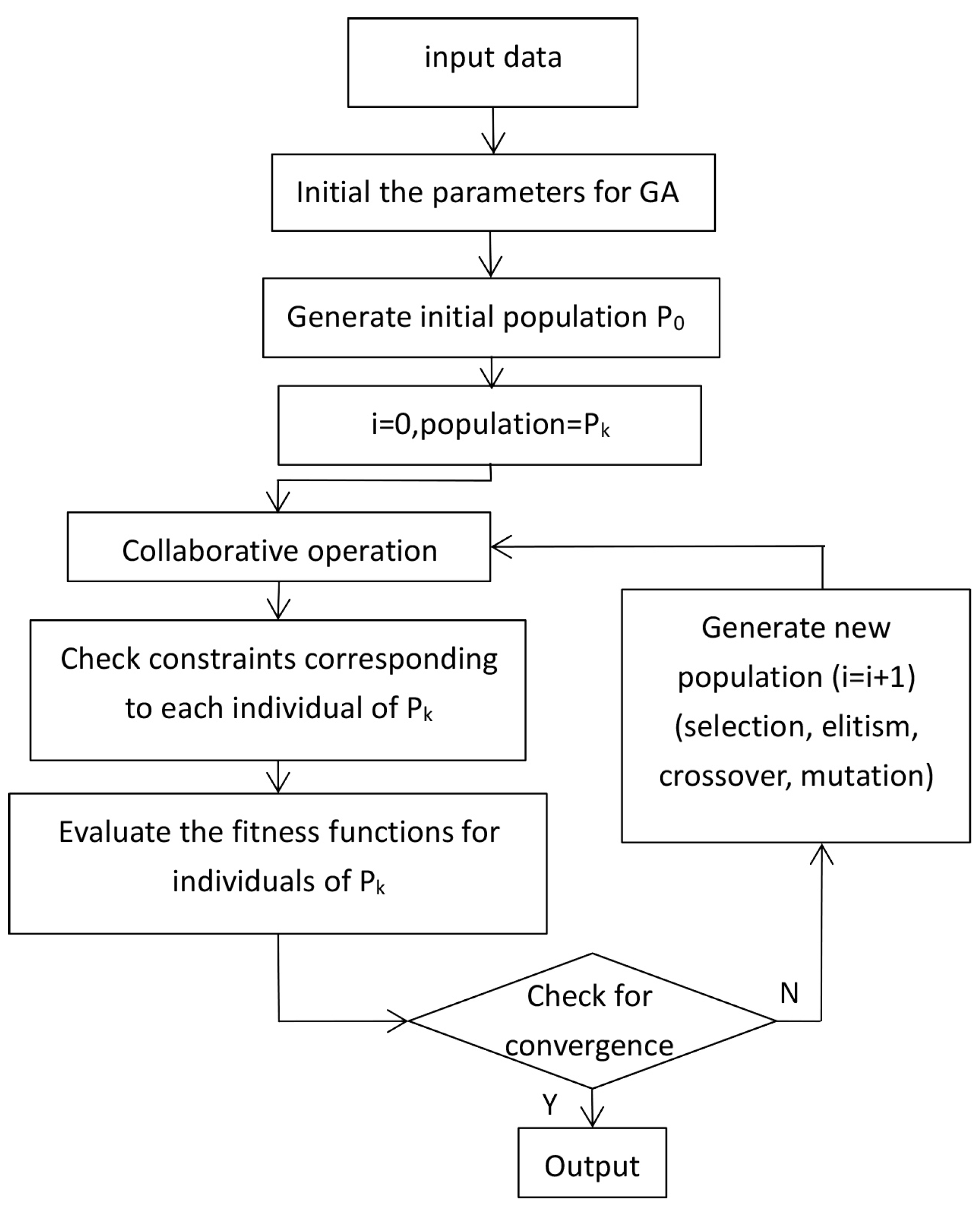
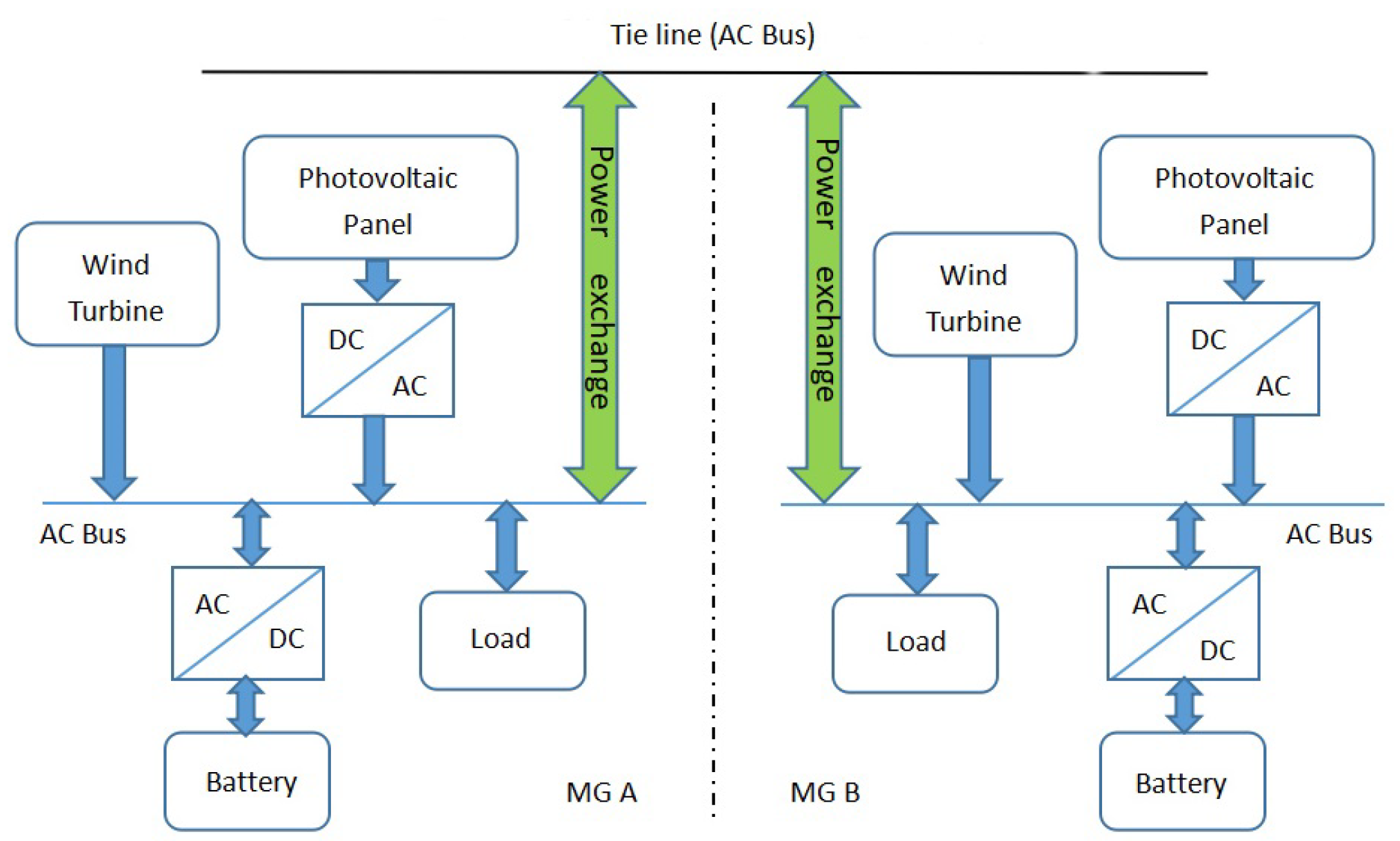
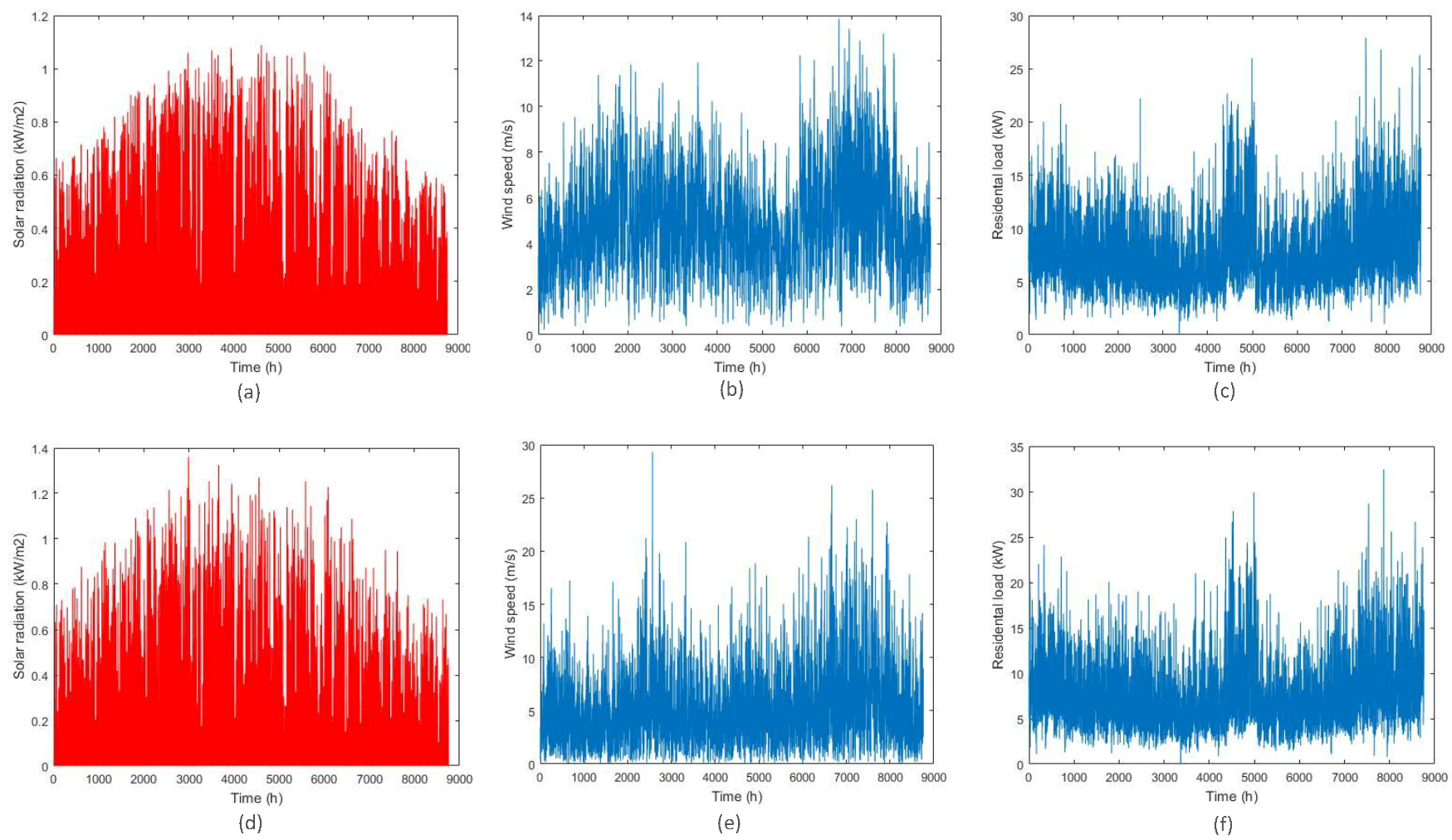
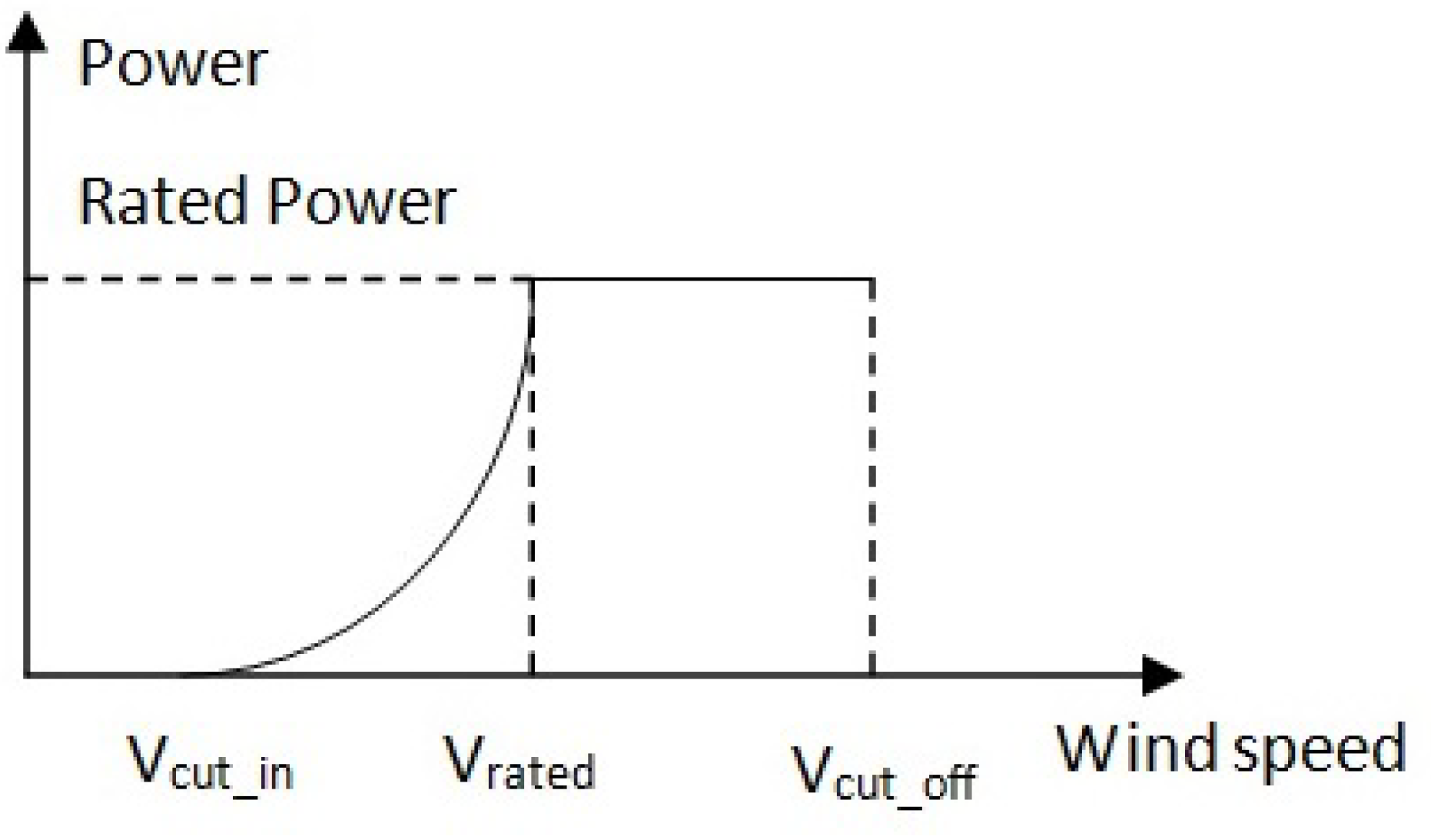
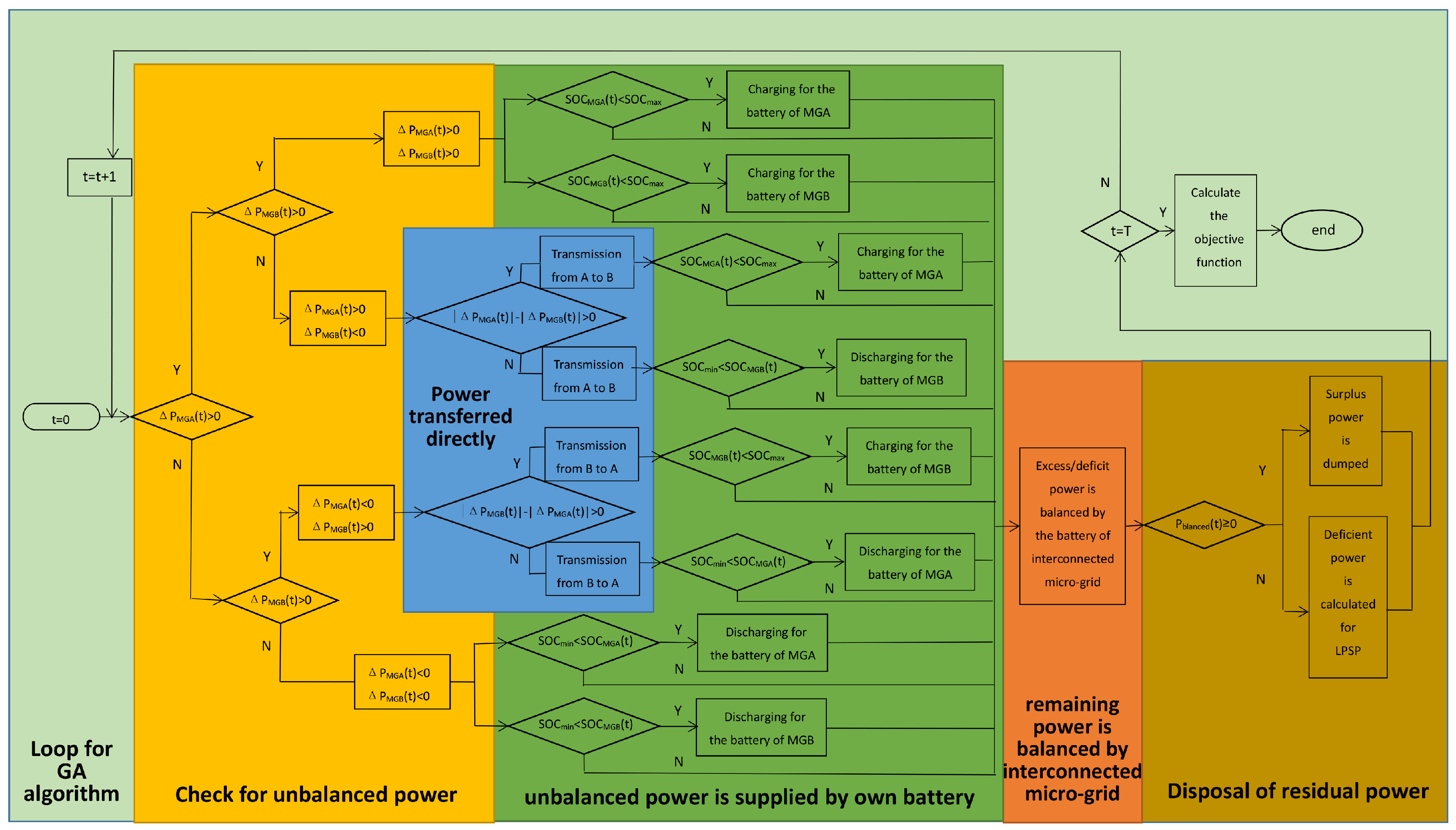
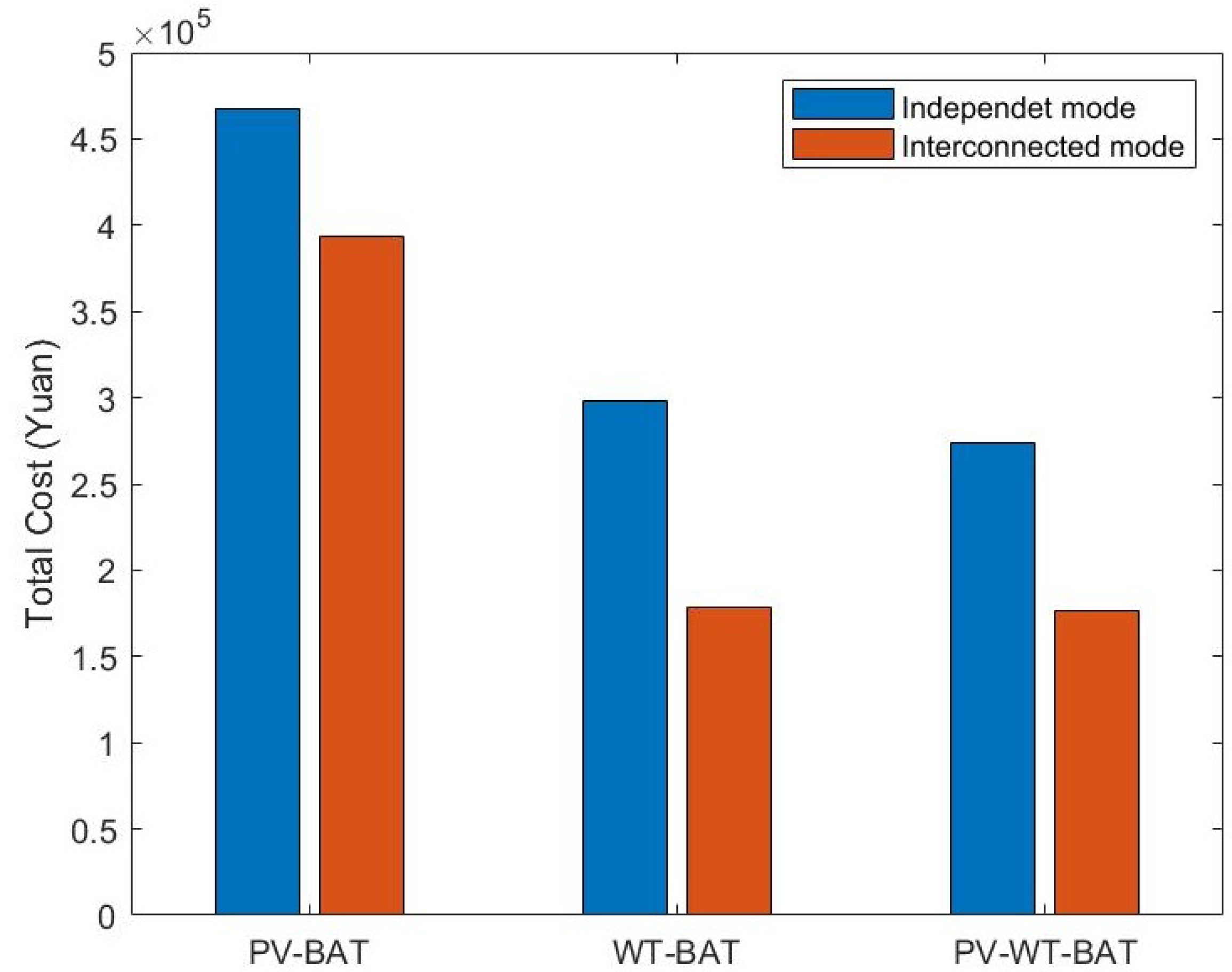
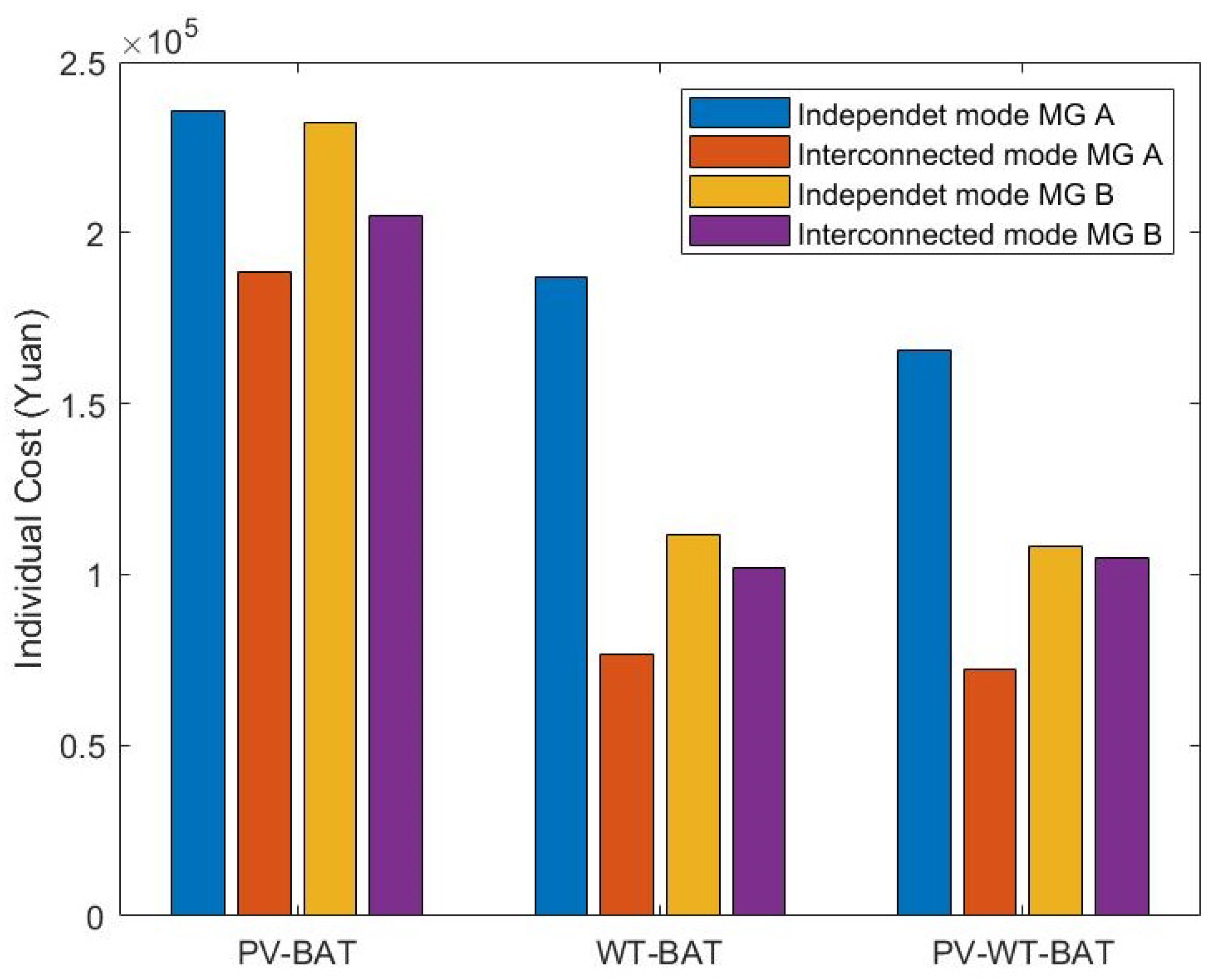
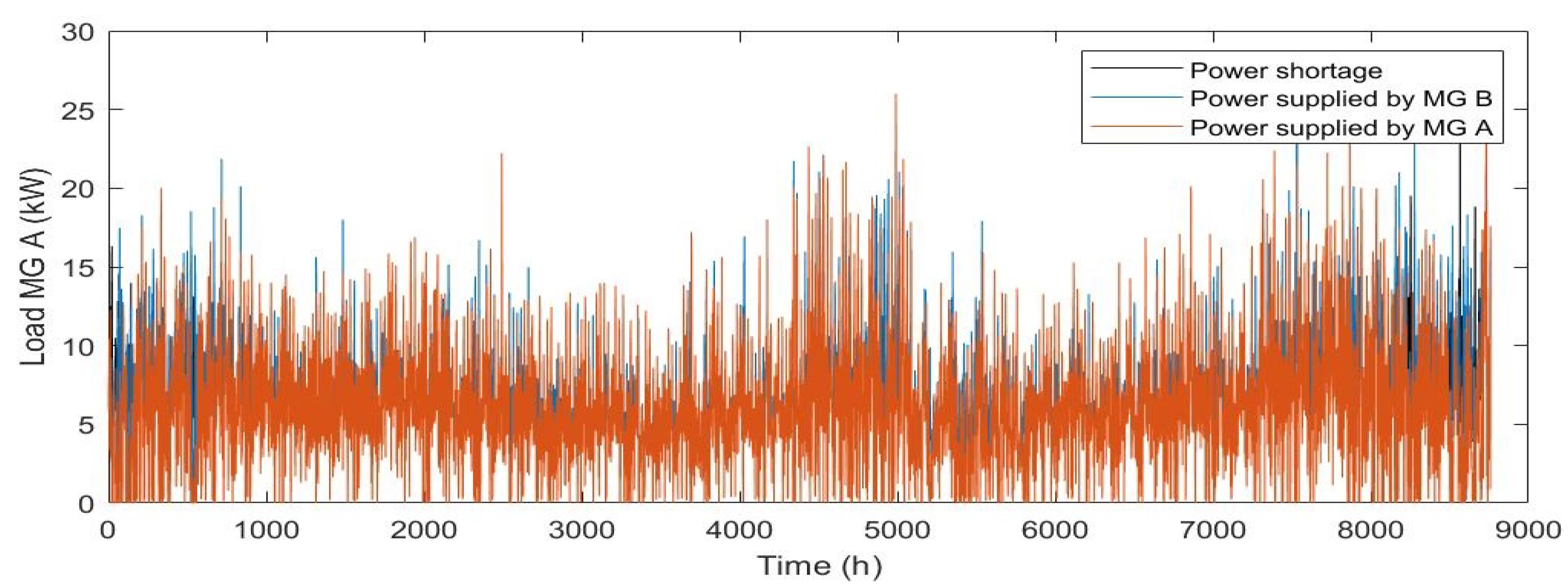
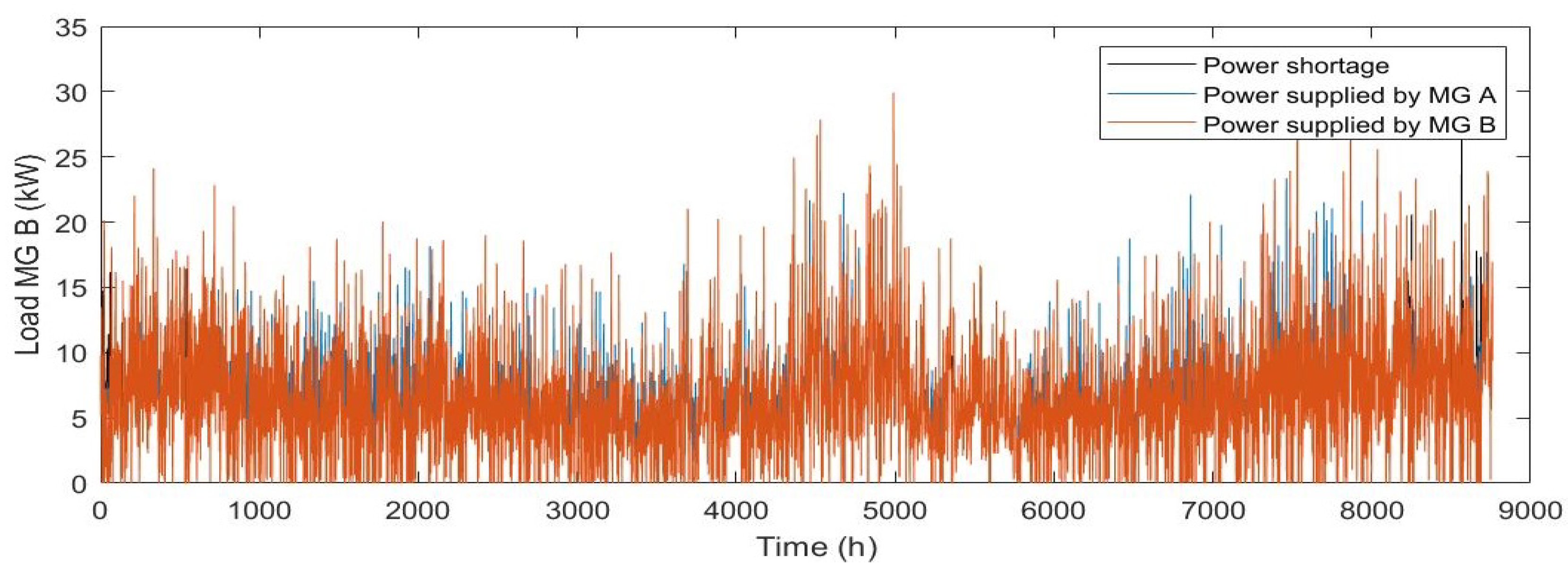
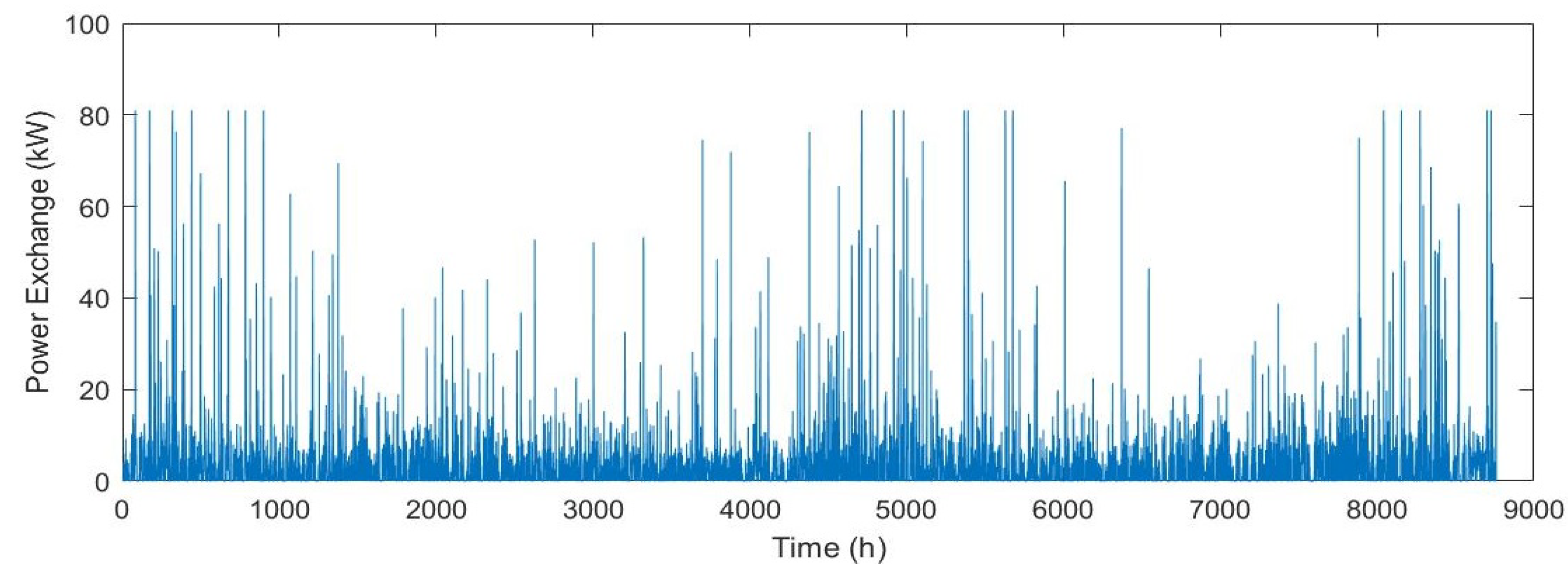
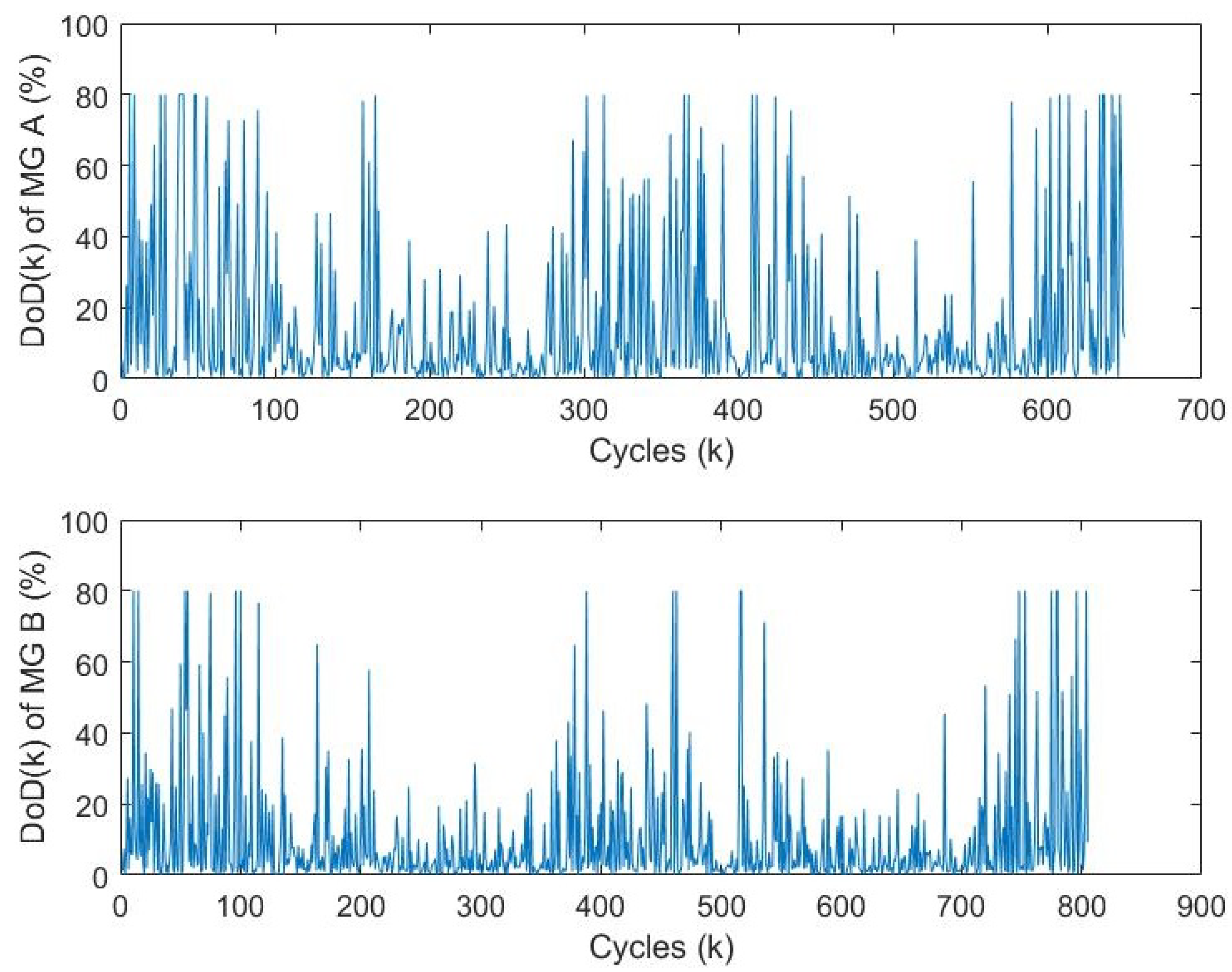
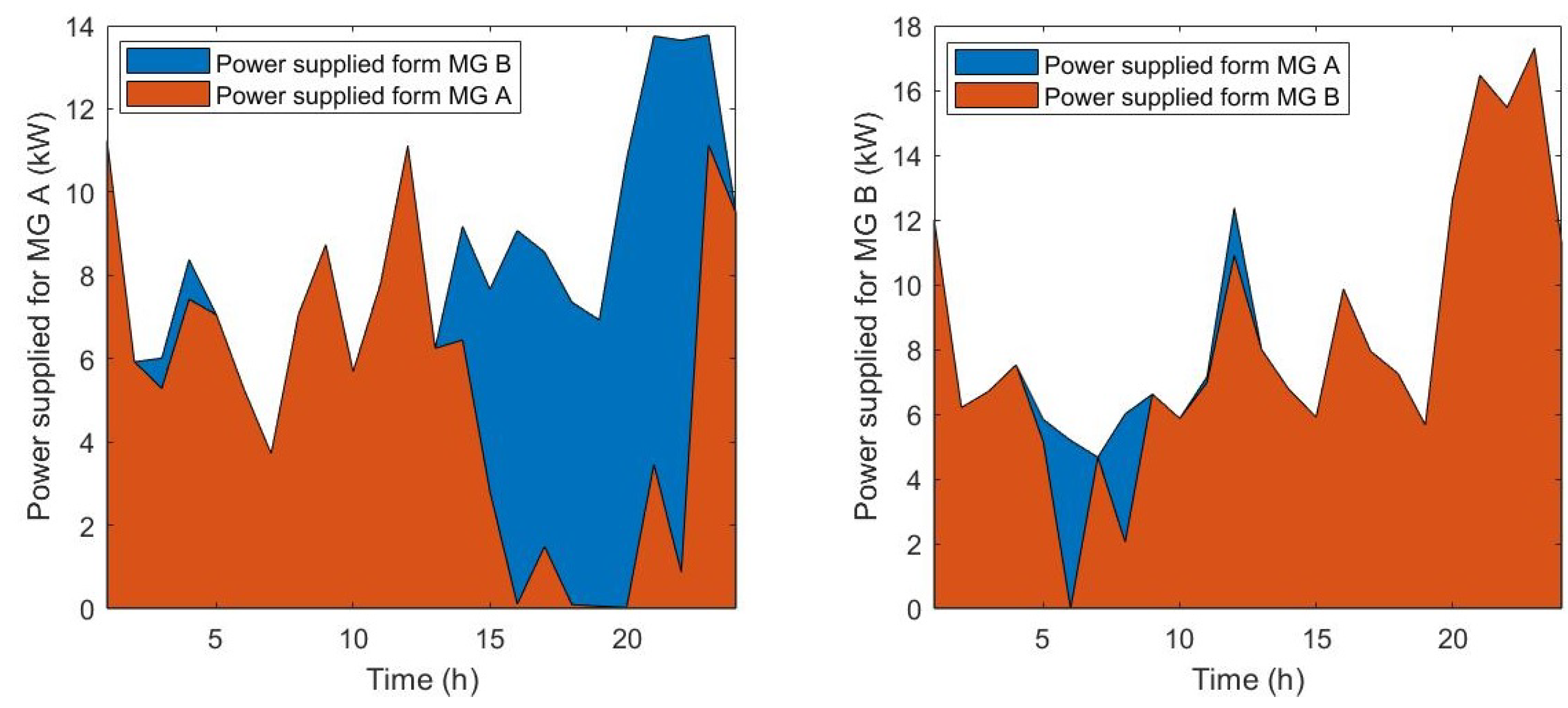
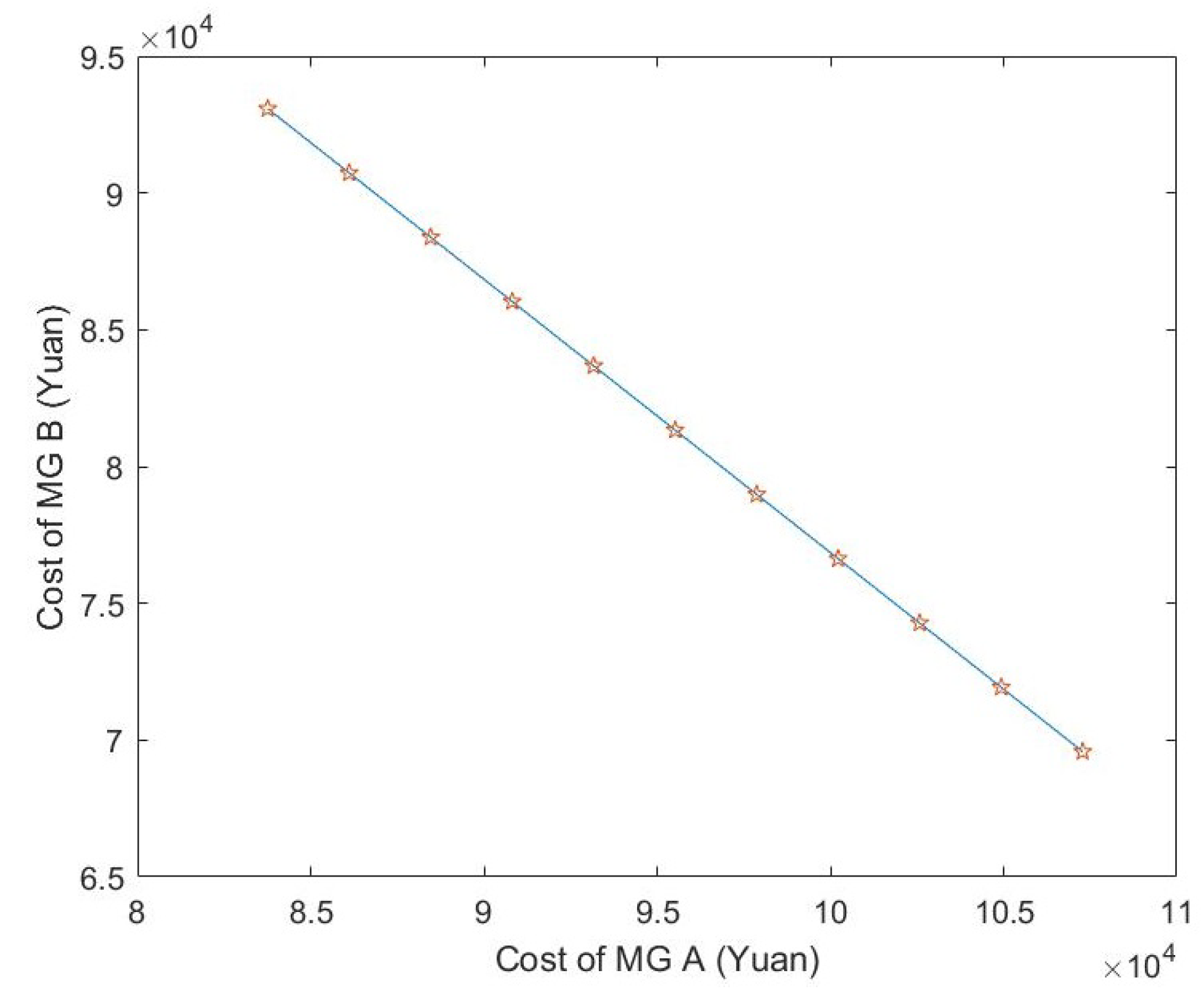
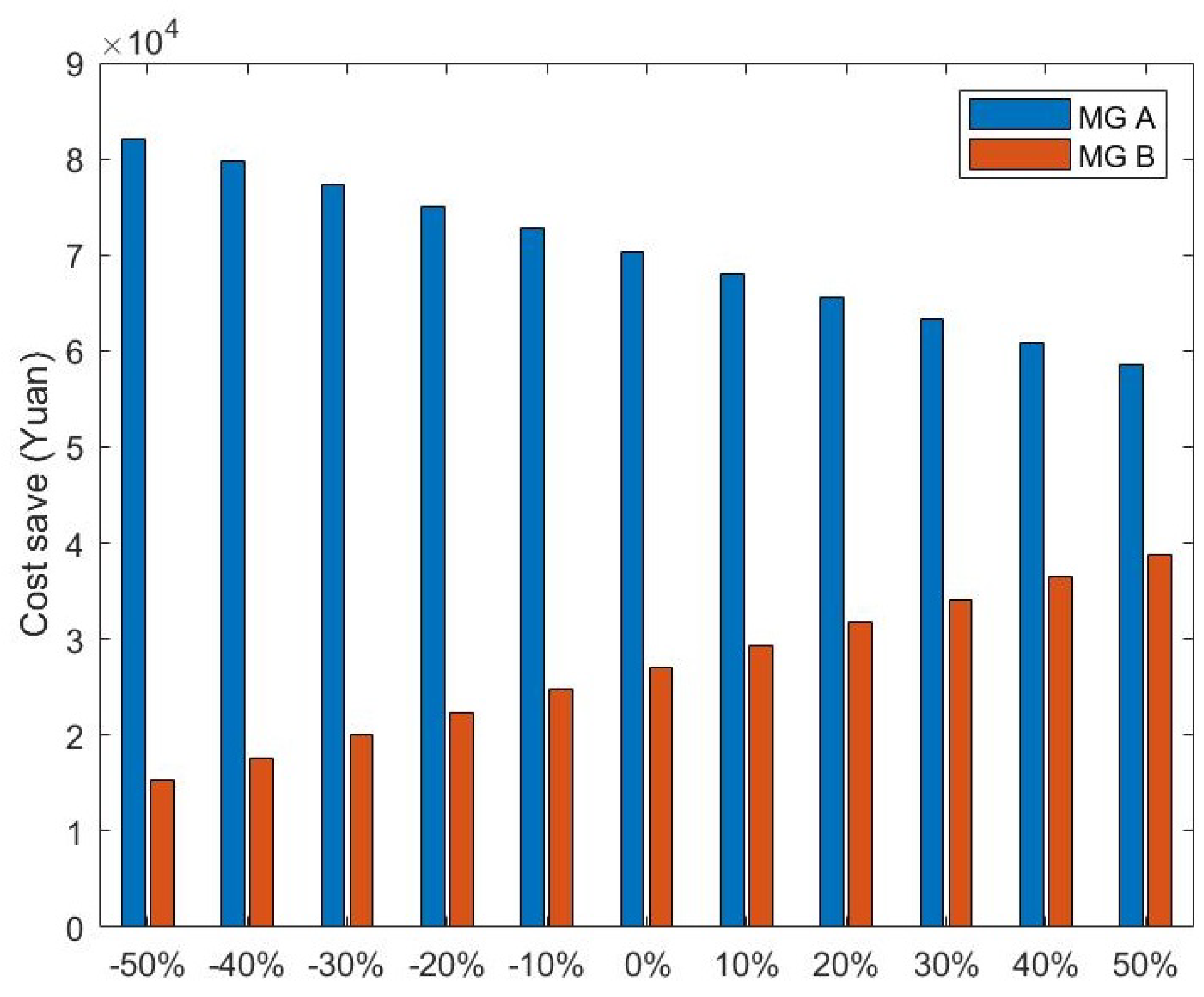
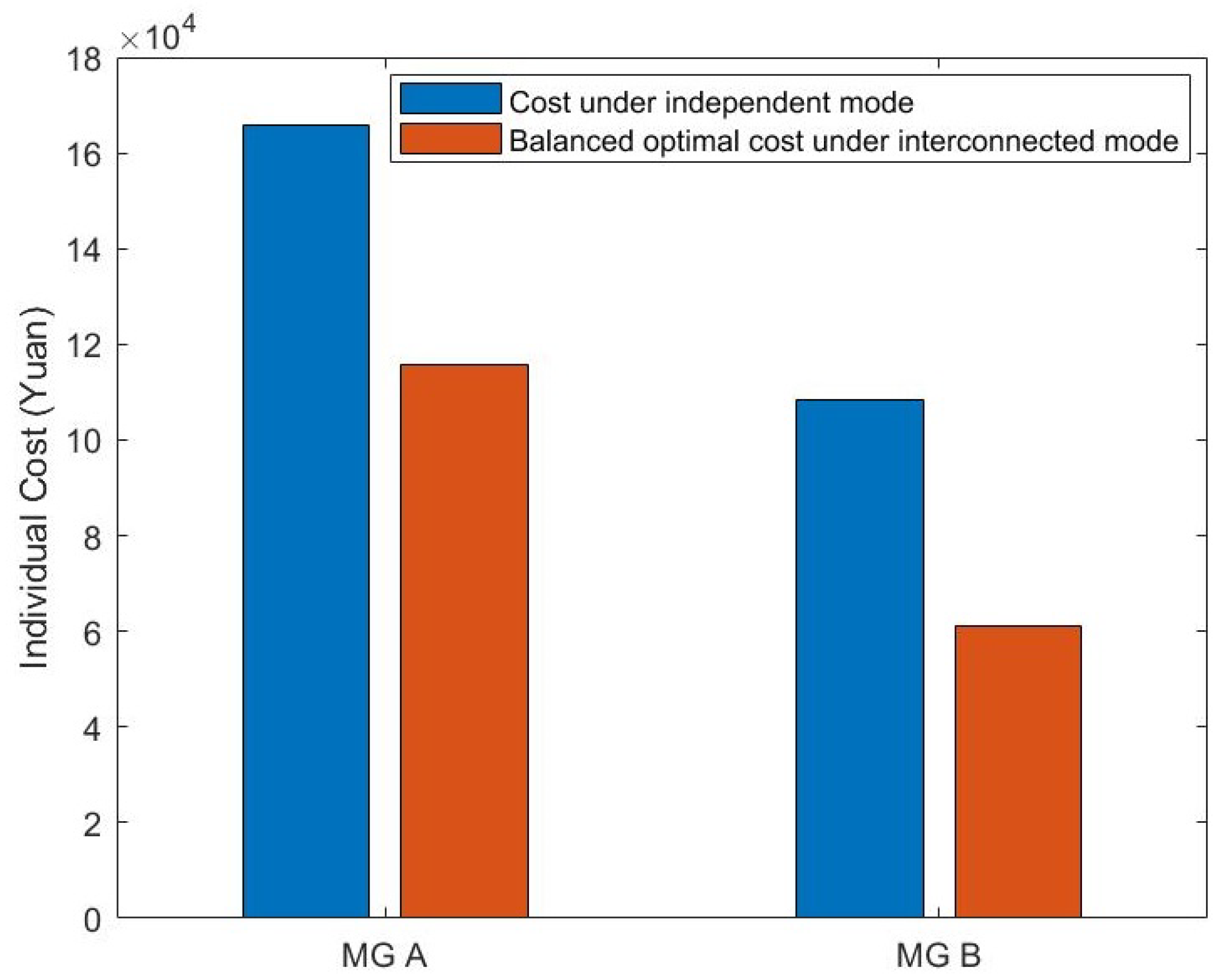
| Component | Parameter | Value | Unit |
|---|---|---|---|
| Wind turbine | 5 | kW | |
| 3 | m/s | ||
| 45 | m/s | ||
| 11 | m/s | ||
| 20 | year | ||
| 4.5 | % | ||
| Solar PV | 300 | W | |
| 19 | % | ||
| 20 | year | ||
| 4.5 | % | ||
| Battery | 100 | Ah | |
| 12 | V | ||
| 93/100 | % | ||
| Tie Line | 95 | % | |
| 50 | year | ||
| Others | 100 | % | |
| i | 6 | % | |
| G | 1000 | W/m2 |
| WT | PV | BAT | |
|---|---|---|---|
| (Yuan/unit) | 14,800 | 750 | 650 |
| (Yuan/unit-yr) | 60 | 20 | |
| (Yuan/unit) | 11,500 | 640 | 520 |
| LPSP | |||||
|---|---|---|---|---|---|
| Independent mode | |||||
| PV-BAT | 3031 | 544 | 1.8% | ||
| WT-BAT | 81 | 444 | 1.62% | ||
| WT-PV-BAT | 46 | 813 | 311 | 1.61% | |
| Interconnected mode | |||||
| PV-BAT | 2633 | 564 | 94 | 1.66% | |
| WT-BAT | 45 | 388 | 85 | 1.66% | |
| WT-PV-BAT | 45 | 22 | 354 | 81 | 1.76% |
| LPSP | ||||||
|---|---|---|---|---|---|---|
| Independent mode | ||||||
| PV-BAT | MGA | 1487 | 293 | 1.66% | ||
| MGB | 1544 | 251 | 1.94% | |||
| WT-BAT | MGA | 54 | 245 | 1.53% | ||
| MGB | 27 | 199 | 1.71% | |||
| WT-PV-BAT | MGA | 25 | 633 | 250 | 1.63% | |
| MGB | 21 | 180 | 161 | 1.60% | ||
| Interconnected mode | ||||||
| PV-BAT | MGA | 1612 | 19 | 94 | 1.65% | |
| MGB | 1021 | 545 | 94 | 1.67% | ||
| WT-BAT | MGA | 19 | 183 | 85 | 1.66% | |
| MGB | 26 | 205 | 85 | 1.67% | ||
| WT-PV-BAT | MGA | 19 | 9 | 130 | 81 | 1.74% |
| MGB | 26 | 13 | 224 | 81 | 1.75% |
| Title 3 | Direct Power Transferred (kW) | Power Stored (kW) | Energy Storage Delivered (kW) |
|---|---|---|---|
| MG A to MG B | 8234.53 | 2779.70 | 41.50 |
| MG B to MG A | 10,895.23 | 8732.39 | 1149.41 |
© 2018 by the authors. Licensee MDPI, Basel, Switzerland. This article is an open access article distributed under the terms and conditions of the Creative Commons Attribution (CC BY) license (http://creativecommons.org/licenses/by/4.0/).
Share and Cite
Huang, Y.; Yang, L.; Liu, S.; Wang, G. Cooperation between Two Micro-Grids Considering Power Exchange: An Optimal Sizing Approach Based on Collaborative Operation. Sustainability 2018, 10, 4198. https://doi.org/10.3390/su10114198
Huang Y, Yang L, Liu S, Wang G. Cooperation between Two Micro-Grids Considering Power Exchange: An Optimal Sizing Approach Based on Collaborative Operation. Sustainability. 2018; 10(11):4198. https://doi.org/10.3390/su10114198
Chicago/Turabian StyleHuang, Yuansheng, Lei Yang, Shijian Liu, and Guangli Wang. 2018. "Cooperation between Two Micro-Grids Considering Power Exchange: An Optimal Sizing Approach Based on Collaborative Operation" Sustainability 10, no. 11: 4198. https://doi.org/10.3390/su10114198
APA StyleHuang, Y., Yang, L., Liu, S., & Wang, G. (2018). Cooperation between Two Micro-Grids Considering Power Exchange: An Optimal Sizing Approach Based on Collaborative Operation. Sustainability, 10(11), 4198. https://doi.org/10.3390/su10114198




